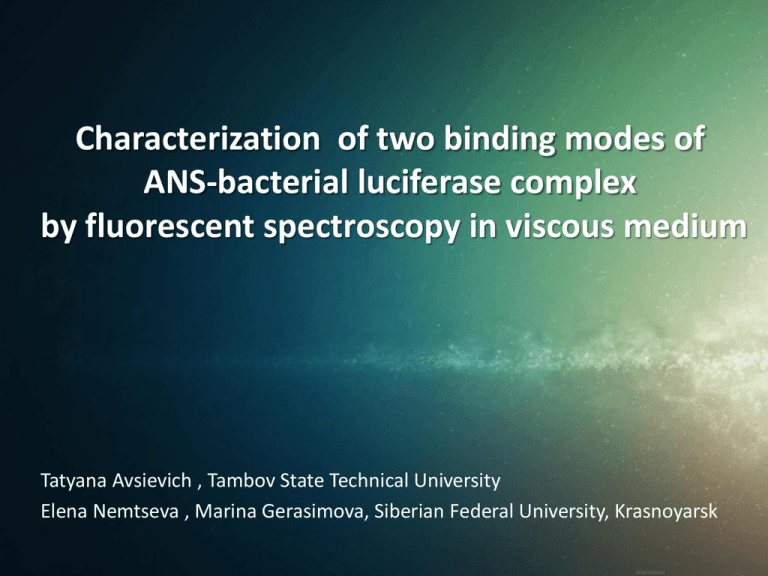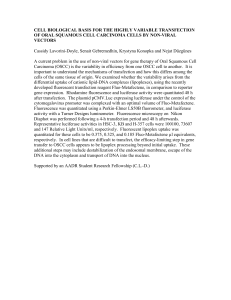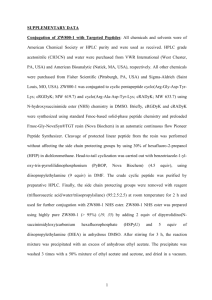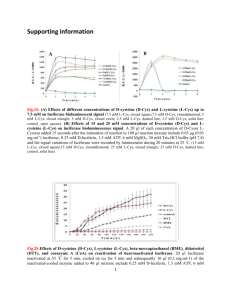Presentation
advertisement

Characterization of two binding modes of ANS-bacterial luciferase complex by fluorescent spectroscopy in viscous medium Tatyana Avsievich , Tambov State Technical University Elena Nemtseva , Marina Gerasimova, Siberian Federal University, Krasnoyarsk Introduction Intracellular media is: • inhomogeneous, • structured, • has a high viscosity. Bioluminescent reaction of bacteria – a model process for the study of the enzyme functioning in environments which approximate intracellular conditions. Fig.1 – The inhomogeneous cytoplasm of the intact mobile cell Dictyostelium discoideum [Medalia O., Weber I., at al. Science, 2002] Introduction Evaluation of protein binding sites under the influence of external factors, an important characteristic of the functioning of enzymes in vivo and in vitro. Objective: to characterize influence of viscous media on the binding characteristics of bacterial luciferase by steady-state and timeresolved fluorescence. Fig. 2 - Native and unfolded conformation of the protein in the presence of osmolytes. [C. Le Coeur at al., Life Sciences and Biology, 2005] Materials and methods: fluorometric titration of bacterial luciferase by 1,8-ANS in different mediums 8-anilinonaphthalene-1-sulfonic acid (ANS) Upon binding to proteins: • Quantum yield increases 2 fold • Spectral shift 50 nm • Electrostatic or hydrophobic interaction • The longer fluorescence life time (>15 ns) has been attributed to the internal binding sites and the shorter (<10 ns) to the external sites Bacterial luciferase Photobacterium leiognathi (L) Buffer 0,05 M (η=1,002 сP) Glycerol, 40 wt%, (η=3,75 сP) Features: • Substrates: long chain aldehyde and reduced flavin mononucleotide • Heterodimer, ~80 kDa • The exact number and affinities of its binding sites have not been determined yet Sucrose, 40 wt%, (η=6,17 сP) Materials and methods: fluorometric titration of bacterial luciferase by 1,8-ANS in mediums of different nature Buffer 0,05 M (η=1,002 cP) The chosen viscous media have the same effect decrease bioluminescence in vitro by more than 2fold compared with the control (buffer 0,05 M) Glycerol, 40 wt%, (η=3,75 cP) Sucrose, 40 wt%, (η=6,17 cP) Methods: Fluorescence spectroscopy Spectrofluorimeter Fluorolog-3-22 (Horiba Jobin Yvon, France) Steady-state fluorescence Time-resolved fluorescence Correction of fluorescence intensities for inner filter effect: I corr I obs 10 ( D360 D470) 2 , I corr – the true intensity of the fluorescence, I obs experimentally measured intensity, D360, D470 – absorption at wavelengths of 360 and 470 nm, respectively The lifetimes were found from the dependence of intensity on time : I t i exp t i , i and i – amplitudes and the lifetimes of the i-components Results: 1,8-ANS fluorescence in the presence of luciferase (fluorescence lifetime) Table 1. - Lifetime components for fluorescence of [ANS+luciferase] (1 , 2 , 3): Media 1 , ns 2, ns 3, ns Buffer 0,05 М 0,6±0,06 5,78±0,06 14,7±1,4 Glycerol, 40% 0,6±0,013 4,77±0,12 12,3±0,08 Sucrose, 40% 0,44±0,01 4,52±0,09 12,4±0,08 Free ANS ANS, bound with external sites ANS, bound with internal sites Fig.3 - fluorescence decays for ANS in the presence of bacterial luciferase in different mediums Results: Deconvolution of steady-state fluorescence titration curve (Iss) into lifetime components 2 and 3 Nonlinear fitting of the titration curves: where y – experimental fluorescence, F is a fluorescence scaling factor Kd - dissociation constant, P - total protein concentration (luciferase), Lt - the total ligand concentration (ANS), n – number of binding sites. Fig. 4 - Deconvolution of ANS fluorescence titration curves at 430 nm into lifetime components (markers) and their nonlinear fitting (straight lines). Iss – overall intensity of the fluorescence of the probe in the steady-state excitation Issf2 – fluorescence intensity of external binding sites (2 =4-6 ns) Issf3 –fluorescence intensity of internal binding sites (3 = 12-14 ns) 8 Results: influence of viscous media on the binding characteristics of the protein Table 2. – Characteristics of 1,8-ANS binding to the bacterial luciferase Media Viscosity, cP 2 -external sites 3 -internal sites Kd1, µM n1 Kd2, µM n2 Buffer 0,05 М 1,002 8,7±4,5 16,1±1,8 1,3±0,3 2,15±0,19 Glycerol 40% 3,75 84±23,8 3,8±2,9 14,2±2,5 1,22±0,68 Sucrose 40% 6,17 44±8,9 1,4±0,7 6,4±2,4 3,2±1,26 o In viscous media the weakening of the binding of the probe with internal and external sites was obtained. This effect is stronger in glycerol than in sucrose. o The number of external binding sites dramatically reduced in viscous media. 9 Discussion: mechanisms of ANS interaction with luciferase o Snp emits when ANS is fixed in non-planar conformation (bound to the protein) o SCT emits when ANS is in planar conformation o SCT is quenched by water molecules o (+)-charged amino acids play role in the interaction with proteins. 460-480 nm 510-540 nm Fig. 5 – The model of two emmiting states of 1,8-ANS [Gufeng at al., Biochimica et Biophysica Acta., 2006] 10 Discussion: mechanisms of ANS interaction with luciferase o Luciferase’s active site contains charged amino acids and a hydrophobic pocket; o ANS competes with the FMH to the binding with luciferase possibly ANS binds to the active site of the protein Adding of glycerin or sucrose causes: The decreasing of the dielectric constant of the medium enhancement of electrostatic interactions increase in rigidity of structure protein difficulties entering ligands in the internal sites or Fig. 4 – CPK representation of bacterial luciferase molecule (PDB id: 3FGC): hydrophobic (green), positively charged (indigo) and other (white) amino acid residuals, FMN in active center is red. Preferential hydration of proteins excess water leads to the quenching of the probe the surface charge of the luciferase is changed no binding 11 Conclusions: 1) From interaction of 1,8-ANS with bacterial luciferase in all investigated media two types of fluorophores with short (5 ns) and long (12-15 ns) fluorescence lifetime are formed corresponding to the binding of the probe with the internal and external sites of the protein molecule. 2) Binding of 1,8-ANS to internal sites of the bacterial luciferase is characterized by a higher affinity (Kd = 1,3 ± 0,9 μM) than with external (Kd = 8,7 ± 0,5 μM). 3) In viscous media with glycerol and sucrose the number of external binding sites of the bacterial luciferase is significantly reduced, the interaction of the probe with all centers weakens. 12





